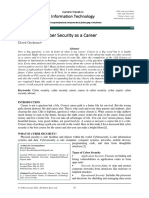0% found this document useful (0 votes)
11 views5 pagesDefender Vs Attacker Part 4
The document compares the roles of defenders and attackers in both soccer and cybersecurity, highlighting their goals, responsibilities, and tools used. Defenders focus on protecting systems and responding to threats, while attackers specialize in finding and exploiting vulnerabilities. A Purple Team combines both approaches to enhance security by integrating offensive and defensive strategies.
Uploaded by
Rehan ZahidCopyright
© © All Rights Reserved
We take content rights seriously. If you suspect this is your content, claim it here.
Available Formats
Download as DOCX, PDF, TXT or read online on Scribd
0% found this document useful (0 votes)
11 views5 pagesDefender Vs Attacker Part 4
The document compares the roles of defenders and attackers in both soccer and cybersecurity, highlighting their goals, responsibilities, and tools used. Defenders focus on protecting systems and responding to threats, while attackers specialize in finding and exploiting vulnerabilities. A Purple Team combines both approaches to enhance security by integrating offensive and defensive strategies.
Uploaded by
Rehan ZahidCopyright
© © All Rights Reserved
We take content rights seriously. If you suspect this is your content, claim it here.
Available Formats
Download as DOCX, PDF, TXT or read online on Scribd
/ 5



































































































